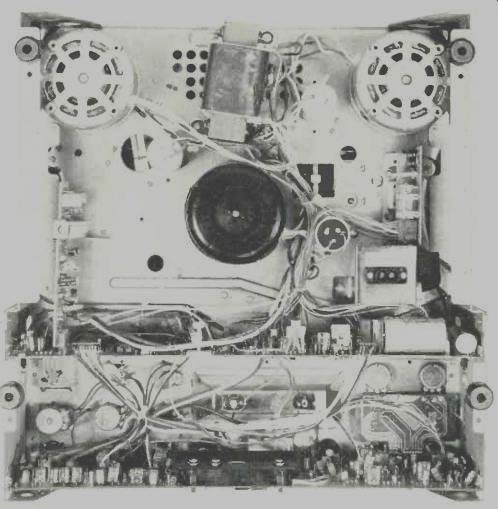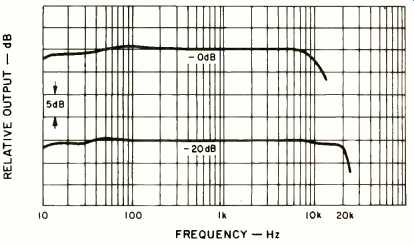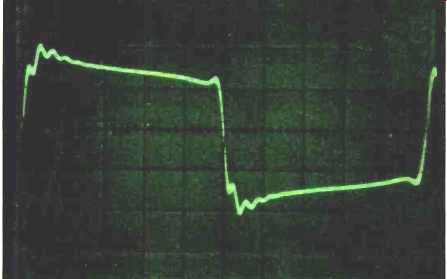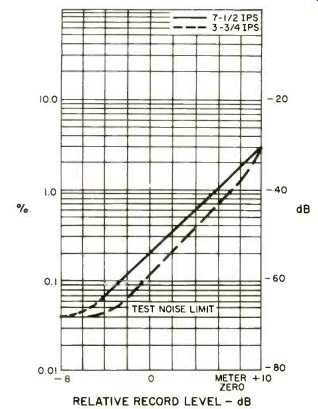
MANUFACTURER'S SPECIFICATIONS:
Frequency Response: 15 Hz to 26 kHz at 7 1/2 ips, 15 Hz to 20 kHz at 3 3/4 ips.
Harmonic Distortion: 2 percent for 1 kHz at 0 dB.
S/N Ratio: 66 dBA at 7 1/2 ips.
Separation: 54 dB.
Crosstalk: 64 dB down.
Erasure: 70 dB.
Input Sensitivity: Mike, 0.2 mV; Line, 50 mV, and Radio, 5 mV.
Output Level: line, 1.5 V; Headphone, 5 mW at 8 ohms; Radio, 0.775 V.
Flutter: 0.09 percent Wtd. Peak at 7 1/2 ips, 0.15 percent at 3 3/4 ips.
Speed: ±0.5 percent.
Dimensions: 18.5 in. (43.5 cm) W x 19.1 in. (45 cm) H x 8.3 in. (19.5 cm) D.
Weight: 37.5 lbs. (17 kg).
Price: $1500.00.


The Tandberg TD 20A open-reel deck incorporates a number of innovations which contribute to its outstanding performance. Perhaps the most significant is the new recording system, which Tandberg calls Actilinear. The improvements were readily apparent in the tests, as discussed later. For a detailed description of the system, the reader is referred to Herman Lia's article in the July, 1978, issue of Audio. The TD 20A continues the current Tandberg design motif with the use of black in contrast with brushed aluminum, large square pushbutton switches, and orderly layout of the lever switches and rotary controls. The three pushbuttons to the left of the head assembly select power On/Off, speed low/high, and reel size small/large. The deck evaluated was a 1/4-track stereo unit with 7 1/2 and 3 3/4 ips speeds. The TD 20A is also available with 15 and 7 1/2 ips speeds in either 1/2- or 1/4-track versions, which are slightly more expensive. To the right of the head assembly are the counter and the light-touch, logic-con trolled pushbuttons for control of tape motion. They are the standard complement with a status light for each function, plus one for Standby and one for Free. The Standby indicator, just above the record button, turns on when either record selector is switched on, confirming that recording can be initiated. If Stop and Wind are pushed at the same time, the brakes are released and the reels are free to rotate for editing purposes. Pushing Stop again causes tape slack to be pulled up and the brakes to be reapplied. There is no pause as such, but it is possible to go in and out of recording with just Record and Stop, and flying start recording is a simple matter of pushing Record with Play held in.
Below are the input level pots, two for each channel, plus a master control which has movable detented marker and level references every 6 dB. One set of input pots can be used not only for line, but for mike if desired. Thus, line/line or line/ mike mixing is possible for each channel in addition to master control of the two mikes, a potentially valuable feature for the user. The On/Off record selector lever switches are neatly placed under the respective input pots, and the always nice bias pots have access holes in between. The mike sensitivity switch, just below the master pot, allows inserting 25-dB attenuation to prevent input overload, always a possibility with present day levels and high-output mikes. The socket for the remote control is just above the master pot.
With the removal of the head assembly covers, accessibility for maintenance tasks is excellent. Of particular interest was the motor-driven shifting of guides, etc., when going into play mode. Tape threading is straight-line with the covers in place, and there are tension arms on both supply and take-up. The level meters have unusual, but easily read, horizontal scales with back illumination. The feeds to the meters are post record equalization, which this reviewer prefers be cause of the better indication of the actual levels to the tape.
The peak-reading response of the meters aids in this regard.
The headphone and the two microphone jacks are immediately below. At the left are separate output pots for the two channels, and lever switches for Left/Stereo/Right playback mode, Off/On Sel Sync, Source/Tape monitor and Off/On edit/cue. The inclusion of Sel Sync is another nicety, essential for adding that second track without re-recording. The edit/ cue switch turns on the electronics for monitoring during fast winds. Muting is normally applied in wind as the tape does touch the play heads, albeit lightly.
Inputs for Lines 1 and 2 for each channel and the line outputs are all phono jacks on the back panel, where the DIN socket is also located. Removal of the recorder from the cabinet revealed two large PCBs which contained the majority of the circuitry. Of particular note was the fact that the logic ICs were in sockets, an expense for the manufacturer, but of great value for anyone who has to do any troubleshooting. The soldering was excellent, with multi-pin plugs used for many of the inter-section connections. The three large capstan and turntable drive motors and other components were mounted within a rugged box chassis. There was good accessibility for service.

Fig. 1--Response with Maxell UD-XL at 71 ips. (Zero reference level is 200
nWb/m which indicates-8 dB on the meter.)

Fig. 2--Response with Maxell UD-XL at 3 3/4 ips.

Fig. 3--Playback of 1-kHz square wave shows little overshoot or ringing.

Fig. 4--Third harmonic distortion vs. level of 1-kHz signal using Maxell
UD-XL. (Zero reference level is 200 nWb/m.)
Performance
The playback responses of the Tandberg deck were checked at both speeds with Ampex alignment tapes. There was very little deviation from flat response with the exception of a rise at the highest frequencies at 3 3/4 ips, which is believed to be a property of the particular test tape. The meter indications were within a dB for the standard levels for all cases. Tape speed was about 0.4 percent fast. The majority of tests were run with Maxell UDXL tape which had been supplied with the deck. Zero on the TD 20A meters is specified to be 10 dB above 185 nWb/m. The reference level for the tests run was 200 nWb/m at 1000 Hz, which was -8 dB on the meters. Record/playback responses at 7 ½-ips (Fig. 1) were run with 10-dB steps from +10 dB to -20 dB (re: 200 nWb/m).
It should be immediately obvious from the plots that these results are exceptional in a number of respects. First of all, with the exception of the highest level, the lower 3-dB down point was at 10.8 Hz, with minor variations in response from head contour effects. The response above 100 Hz shows very little variation out to 20 kHz, and to over 30 kHz at-20 dB.
The responses shown were swept from 20 Hz to 20 kHz, with additional points taken at the extremes to find the end points. In other words, that ruler-flat response at 0 dB was really there. What is shown is not the result of drawing a line between two data points. The response at +10 dB extends from 14 Hz to 11.0 kHz, definitely an outstanding result.
Finally, I would note that these superb, smooth responses show the results for both channels, one plotted on top of the other. At 3 3/4 ips (Fig. 2) the responses extended from 8.4 Hz to 10.7 kHz at 0 dB, and from 7.7 Hz to 21.3 kHz at-20 dB, both exhibiting ruler-flat playback over most of the range.
The results with TDK Audua were substantially the same, and those with Ampex 456 and Memorex Quantum were very close. A slight touch with the front panel adjustable bias would have eliminated the discrepancies. The response in Sel Sync was from 180 Hz to 6 kHz at 7 1/2 ips and from 180 Hz to 2 kHz at 3 3/4 ips. This is satisfactory for the purpose at 7 1/2 ips, but was judged somewhat marginal at the lower speed.
Input sensitivity on Mike was 0.16 mV and on either line input was 46 mV, both a bit better than spec. The input overload point was at 21 mV for Mike, 7.0 V for Line 1 and 5.2 V for Line 2. Output clipping occurred at a level equivalent to +13.4 dB relative to meter zero, lots of headroom above maximum tape levels. Settings of the separate input pots for the same gain were close to each other, though not exact. Switching off the record selector for one channel automatically feeds its pots to the other channel if it is in a record mode, making a 4-input mono mixer. The two sections of the master pot were within a dB of each other over a 50-dB range from maximum setting. The mike attenuator and the level markings around the master pot were accurate enough for the intended purposes. The output levels were right to spec: 1.5 V from line and 5 mW with an 8-ohm load on head phone. The frequency response of the meters extended to 9.7 Hz on the low end, certainly needed with the excellent low frequency record/playback response. At the higher frequencies, the meters had greater deflection, being post record EQ, reaching a peak of +18 dB, relative to 1 kHz, at 23 kHz before rolling off. The dynamic response was much faster than a VU meter, requiring about 100 mS for full deflection. This is not as fast, however, as called for in standards for peak reading meters. Decay time was about 2 seconds. The readability was excellent with lighting behind the translucent scales. The calibrations were within a fraction of a dB from -24 to +3 dB.
The needles were slightly short for easy reading above 0 dB, but such levels should be a rare occurrence.
Variations in line voltage from 110 to 130 V caused barely measurable changes in tape speed, quite insignificant. Tape speed varied most right near the end of a 7-inch reel, but the plots showed just minor deviations. The flutter at 3 3/4 ips was typically 0.07 percent W_rms and 0.10 percent Wtd Pk, and at 7 1/2 ips the flutter was 0.018 percent W_rms and 0.03 percent Wtd. Pk. All of the results were within manufacturer's specifications, but the figures for 7 1/2 ips are especially good. The average wind times for 3600 feet on a 10 1/2-inch reel were 115 seconds, which is quite good.
All tape motion actions were smooth and prompt, without any foul-ups in the purposeful button punching. Going from fast wind to play mode took 4 seconds at most, and that was with 10 1/2-inch reels at maximum speed. Pushing Stop and Wind always obtained the free condition unless there was a purposeful delay between actuating the two buttons. Stop usually pulled up most of any slack to allow going back into Play, but if extra tape had been pulled out, a little hand snugging was needed before hitting Stop. The 7-inch reels were held on securely with spring-loaded retainers. Slip-in adapters were used to accommodate the 10 1/2-inch reels.

Fig. 5--Third harmonic distortion vs. frequency with Maxell UD-XL at a constant
record level, that for 200 nWb/m at 1 kHz, which indicates -8 dB on the meter.

Fig. 6--End-of-reel tape speed variations at 3 3/4 and 7 1/2 ips together
with wow and flutter at both tape speeds, weighted on both peak and rms basis.
Listening and Use Tests
All maintenance tasks were very easily accomplished after removal of the snap-on covers. The TD 20A was operated through a number of cycles without the covers to allow observation of the motor-driven guide-lifter and play-head shield. The actuation was always smooth and much quieter than some solenoid types. There had been some question on the desirability of having the tape contact the play head in a wind mode. There was a definite advantage in being able to cue by ear, but would wear be a problem? It was determined that the tape/head contact pressure was very low, leading to the conclusion that such wear should be minimal.
All knobs were of medium size with fluting for easier turning, which was quite smooth. The lever switches were spring loaded which gained positive action from one position to another. All switchable functions performed as called for with complete reliability. The instruction book has 32 pages of helpful information. The format is quite open, making for easy reading of the excellent exposition. There are many well-chosen illustrations including signal-path block diagrams showing how to connect for sound-on-sound, echo, and other special effects. There is no schematic to satisfy the circuit freaks, but the instructions required by the serious audiophile are there, presented with a refreshing clarity.
In the recordings made, stop clicks were down into tape noise and just detectable. At no time were record clicks observed. Making recordings brought satisfaction both in the results obtained and in the utilization of the various features.
The TD 20A easily met the challenges of the sources I had available. There was no way to really exercise the low end: 10 Hz from what and through what? Recording levels had to be very high before there was much evidence of strain. The meters were easy to work with, and the calibration did appear to be quite appropriate for the post-EQ feed. I did not have a convenient way to take the Tandberg for on-location recording. That would be a good use for the deck with its light weight and high quality, and there is an accessory travel/shipping container available. There is also a wireless PCM infrared remote-control unit that sells for about $200.00.
The Tandberg TD 20A open-reel deck is an outstanding machine with unsurpassed flatness of frequency response and very low distortion. Also not to be overlooked is the fact that the machine's heads and bias circuitry have the capability of matching the yet-to-be-marketed open-reel metal-particle tapes. This and other features of the recorder make it most worthy of consideration by the serious audiophile.
-Howard A. Roberson
(Audio magazine, Mar. 1979)
Also see:
Tandberg Series 3000X Stereo Tape Deck (Mar. 1971)
Tandberg 6000 Series Tape Deck (Jul. 1970)
Tandberg TCD 3014 Cassette Deck (Sept. 1984)
Studer-ReVox Model B77 Open-Reel Tape Recorder (Sept. 1978)
OPEN-REEL vs. CASSETTE (April 1977)
Logic Control of Tape Recorders (Apr. 1973)
= = = =